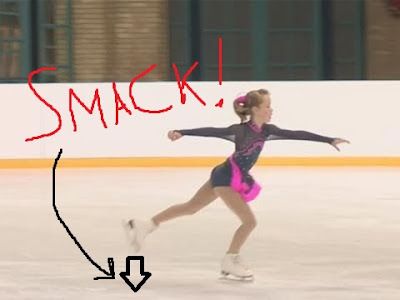Skating 101 - Jumping, The Difficulty Curve
In the last post in this series, we looked at the basic rules of jumping in skating and the breakdown of jumps into the distinct categories of "toe" and "edge" jumps.
The toe and edge jumps combine together in an order of supposed ascending difficulty as follows:
The toe and edge jumps combine together in an order of supposed ascending difficulty as follows:
- Toe loop ("easiest")
- Salchow
- Loop
- Flip
- Lutz
- Axel ("hardest")
But what do I mean by 'supposed' ascending difficulty? In my opinion, the order of difficulty is pretty accurate if you look at it from a roughly empirical angle. The further down the list you get then the more complex the actions required to execute them correctly become. However, people learn in different ways and some people find they actually prefer a jump that is traditionally thought of as "harder" over an "easier" one. Personally, my current preference tends to be whichever one is working better on any given day!
"Working better on any given day," you hear me say? Ice skating is monumentally temperamental across all the skills you learn, but this is no truer than with the jumps. Even when you think you've conquered a particular jump then you'll often find your ability to execute it cleanly will vary on even as little as a day-to-day basis, which is largely what makes free skating as a sport so exciting to watch - will the competitors land big jumps today, or fall them? Of course, with enough practise you can get consistency of execution, but that's a long road to walk.
The beauty about the gradual increasing difficulty of the jumps is that they build the skills you need for later jumps by teaching you important principles in easier situations. For example, you'll learn all of the jumps at single rotation initially, but how does one make the transition to doing those jumps with a double rotation? Well, to begin with, toe loop and Salchow can sometimes be thought of as more like 0.5 and 0.75 rotation jumps respectively, which is technically incorrect, but the point is you learn them with a degree of leniency to getting the full rotation out. As you progress up to the loop, flip and Lutz then you're forced to progress up to doing a full single rotation, so by the time you reach learning the vaunted single Axel then you're used to doing the jumps at a full, single rotation in the air.
The Axel itself requires a cheeky extra half rotation in the air on top of the one you'd normally do, for a total of 1.5 rotations. That extra half rotation works as the perfect stepping stone into learning how to do the jumps at double rotation, as you have to learn the principles of correct air positioning for faster rotations, but without having to commit to a full double rotation straight away. Once you've learned the 1.5 rotation of the Axel then you can take that next step up by going back to the easier end of the jump list and doing the jumps in order again, perhaps with toe loop as a 1.5 rotation and Salchow as a 1.75 rotation as you build up into the full two rotations - it's a remarkably clever progression system!
With difficulty out of the way then you can start to look at how each jump works individually, but before we move on then it's worth noting that there are plenty of other jumps in skating. For example: various split jumps, backflips, variations of the standard jumps such as the half loop and others, but most of those are considered decorative additions, or linking moves, when compared to the more demanding levels of difficulty that come from doing the standard jumps at ever greater revolutions.
We're almost onto each individual jump's description - next up: The Disclaimer!
The beauty about the gradual increasing difficulty of the jumps is that they build the skills you need for later jumps by teaching you important principles in easier situations. For example, you'll learn all of the jumps at single rotation initially, but how does one make the transition to doing those jumps with a double rotation? Well, to begin with, toe loop and Salchow can sometimes be thought of as more like 0.5 and 0.75 rotation jumps respectively, which is technically incorrect, but the point is you learn them with a degree of leniency to getting the full rotation out. As you progress up to the loop, flip and Lutz then you're forced to progress up to doing a full single rotation, so by the time you reach learning the vaunted single Axel then you're used to doing the jumps at a full, single rotation in the air.
The Axel itself requires a cheeky extra half rotation in the air on top of the one you'd normally do, for a total of 1.5 rotations. That extra half rotation works as the perfect stepping stone into learning how to do the jumps at double rotation, as you have to learn the principles of correct air positioning for faster rotations, but without having to commit to a full double rotation straight away. Once you've learned the 1.5 rotation of the Axel then you can take that next step up by going back to the easier end of the jump list and doing the jumps in order again, perhaps with toe loop as a 1.5 rotation and Salchow as a 1.75 rotation as you build up into the full two rotations - it's a remarkably clever progression system!
With difficulty out of the way then you can start to look at how each jump works individually, but before we move on then it's worth noting that there are plenty of other jumps in skating. For example: various split jumps, backflips, variations of the standard jumps such as the half loop and others, but most of those are considered decorative additions, or linking moves, when compared to the more demanding levels of difficulty that come from doing the standard jumps at ever greater revolutions.
We're almost onto each individual jump's description - next up: The Disclaimer!



Comments
Post a Comment